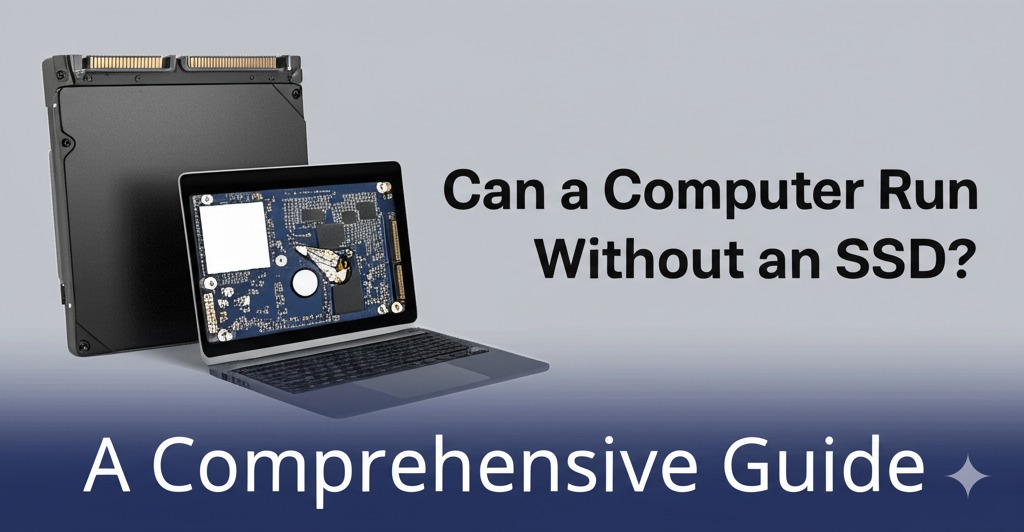Introduction
In the world of computers, SSDs (Solid-State Drives) have become a crucial component in modern systems, providing faster data access, improved performance, and enhanced user experience. But what happens if your computer runs without an SSD? Is it even possible? Can it still perform efficiently without one?
In this article, we’ll explore the role of an SSD in a computer, whether you can run a computer without one, and how it impacts your system’s performance. Read on to understand the advantages of SSDs and why many users choose to incorporate them into their setups.
What is an SSD and Why is it Important?
What is an SSD?
An SSD, or Solid-State Drive, is a type of storage device that stores data on flash memory, rather than the spinning magnetic disks used by traditional Hard Disk Drives (HDDs). This makes SSDs much faster and more reliable, offering significant improvements in performance.
Why SSDs Matter for Computers
SSDs are essential for improving boot times, loading speeds for programs, and overall system responsiveness. With faster read and write speeds, SSDs can dramatically enhance a computer’s performance. They are often used for storing the operating system, applications, and frequently accessed files.
Can a Computer Run Without an SSD?
The Role of SSDs in Modern Computers
While SSDs are not strictly necessary for a computer to run, their absence can result in noticeable performance issues. Most modern computers rely on SSDs for faster boot times and quicker access to files. Without an SSD, your computer will likely use a traditional HDD, which is much slower.
Can a Computer Function with Just an HDD?
Yes, a computer can still run without an SSD. However, it will primarily depend on an HDD (Hard Disk Drive) for storage. Here’s what you should expect when running a computer without an SSD:
- Slower Boot Times: The operating system will load slower since HDDs take longer to read and write data compared to SSDs.
- Longer Program Load Times: Applications and files that rely on your storage will take more time to open, making multitasking less efficient.
- Overall Slower Performance: While basic tasks such as web browsing and document editing will still function fine, resource-intensive tasks like gaming, video editing, or large-scale data processing will be noticeably slower.
Pros and Cons of Running a Computer Without an SSD
Pros
- Lower Cost: Without an SSD, you can save money, as HDDs are typically much cheaper per gigabyte than SSDs.
- Larger Storage Capacity: HDDs tend to offer larger storage capacities for a lower price, making them a good option if you need significant storage space for less money.
- Sufficient for Basic Tasks: For basic computing tasks such as browsing, document editing, and watching videos, an HDD can still perform adequately.
Cons
- Slower Performance: The most significant downside of running a computer without an SSD is the slower speed. Everything from booting the computer to opening applications will take more time.
- Lower Reliability: HDDs have mechanical parts that are more prone to failure than SSDs. This means that an HDD may not last as long, especially in environments with physical shocks or vibrations.
- Energy Inefficiency: HDDs consume more power and generate more heat than SSDs, which can impact battery life in laptops and the overall energy efficiency of your system.
What Happens When You Add an SSD to Your Computer?
Boosting Performance
When you add an SSD to your system, it’s like upgrading your computer’s engine. You’ll notice faster boot times, quicker load times for applications, and an overall snappier experience.
Hybrid Storage Solutions
Many computers now offer a hybrid solution, where the operating system and critical programs are installed on an SSD, while larger files and less critical data are stored on an HDD. This gives you the best of both worlds: the speed of an SSD for essential tasks and the capacity of an HDD for mass storage.
Conclusion
Can a computer run without an SSD? Yes, but it will come with noticeable limitations in performance. While you can still use a computer with just an HDD, upgrading to an SSD will significantly improve the system’s speed, reliability, and overall user experience.
If you’re looking to enhance your computer’s performance, upgrading to an SSD is one of the best investments you can make. Not only will it help with boot times and program loading, but it can also improve the longevity and efficiency of your computer.

Caleb Carlson is a contributing writer at Computer Site Engineering, specializing in computer technology, software trends, and hardware innovations. His articles simplify complex tech topics, making them accessible to readers of all levels.





